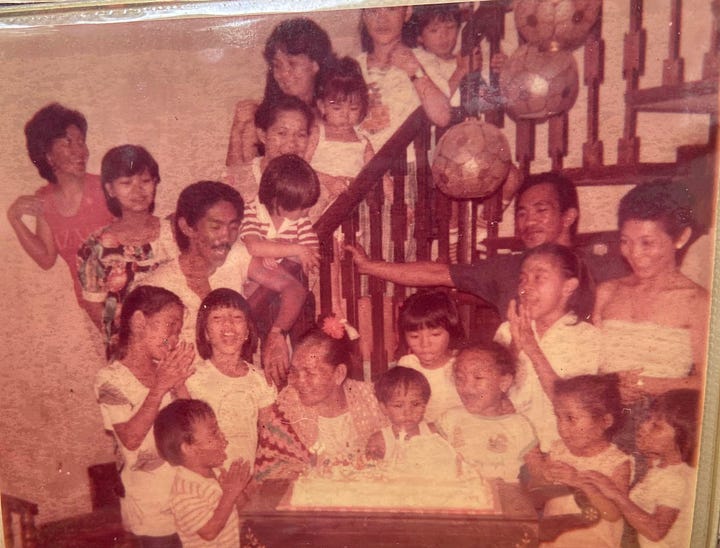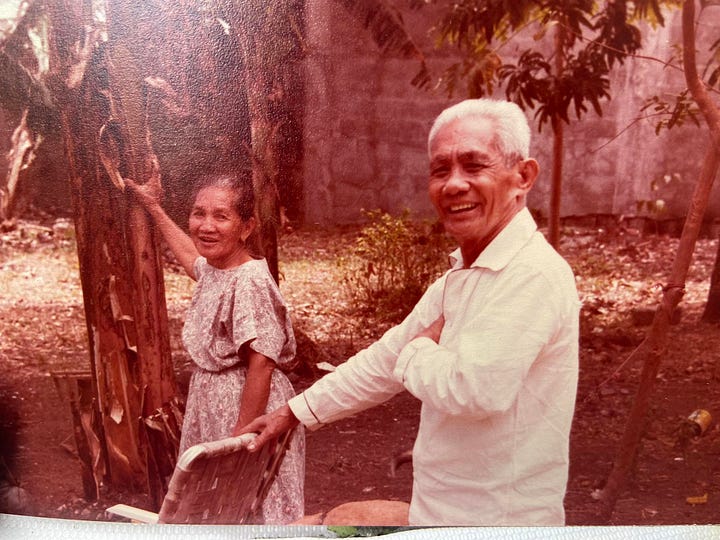This was a submission to the 2020 Doreen Gamboa Fernandez Writing Awards which didn’t make the cut, but I’m reposting a revised version here. There’s no recipe but this dish, and the memories that it evokes brings me back to those summer holidays at Tatay and Inay’s.
The summers spent at my grandparents home in Candelaria Quezon are some of the best food memories I have. Simple food, fuss-free, nose-to-tail cooking, my first taste of barakong kape at the age 8 and Gotong Batangas. Inay (my maternal grandmother) was an avid cook and more often than not, was organised in the kitchen with meals from breakfast to merienda to dinner. But at odd times, Gotong Batangas is the favourite take-away meal.
Before Ubereats food deliveries from restaurants, honest-to-goodness street food were the fast food options on offer. Makeshift carts with wheels sprout like mushrooms at the early signs of dusk along the short stretch of Cabunag Street and the corner of the main highway. This was from the late 70s to early 80s in Candelaria Quezon. A small township which connects Lipa Batangas via San Juan all the way to Padre Garcia. Street hawkers sell balut (boiled fertilised duck eggs), mani (steamed peanuts), popcorn, fish balls and gotong Batangas - a soupy stew, cooked low and slow, made from beef shanks with chopped beef heart, liver, intestines and lungs, flavoured with local cane vinegar, garlic, onions, lots of peppercorns and tinted with the orange hues from atsuete (annatto seeds). The soup is served from massive tall pots simmering on top of portable stoves, where the only glimpse of the soup is through the light from the small kerosene lamp wafting with black smoke as the southern breeze cools the evening. Inay would ask us to accompany her to the corner street 50 metres from the house. We bring our own kaldero (pot) with a lid. This is take-away dinner back in the day.
I remember peering into our “take-away” pot and seeing an assortment of buoyant shapes swimming in orange tinted waters. The main dining room is set for the adults. The grandkids are set up at the back where my grandfather’s workshop and the dirty kitchen is - a big heavy wooden table with long benches. The bantering stops and we raise our mismatched Nescafe and Noritake cups to sip our warm soups, sharing the limited cuts of innards from our ration and pouring all the soup on our rice. Dessert is always home-made ice candy and tall tales from my Titos.


When one of my Titos married to a family of butchers from Tanauan Batangas, the round the clock menu at Inay’s changed and home made gotong Batangas became one of the specialties. Tatay (grandfather) Tanauan was a stocky man and from my view looking up, he looked like a giant, like Hagrid from the Harry Potter series. He was a butcher by trade and his graciousness and humour I remember to this day, as he indulged the same interrogation each visit when small inquisitive eyes stare at his stump - he had one of his arms amputated. His animated stories of working at the market and accidentally cutting off his arm was always the same story the kids would listen to, wide eyed, all ears and more in awe than fearful. When the in-laws visit, the usual lunch was pork estofado (pork hock stew cooked in soy sauce, vinegar and saging na saba - plantains). Tita (auntie) Minda would start the prep as soon as the bags of meats arrive in the kitchen. The buzz will start with the clang of pots, pans and zing-zing sound of knives being sharpened like a symphony and the adults dancing to the tune, performing each time there is a crowd to feed. Inay (grandmother) will be sorting the meats in bags for freezing and the grandkids are shooed away from the kitchen. “Maglaro na kayo doon at tatawagin pag kakain na!” (Go out and play and you’ll be called when it’s time to eat!). Always inquisitive about food, I look in the big pot of pork estofado - big chunks of brown shiny pork hock, skin glistening from the fat, strands of bulaklak ng saging (banana blossoms) and there would always be one or two pieces of pandesal. I asked - “why is there pandesal in here?”. Tita Minda would reply, “it is to soak the sauce as well as it serves as a thickener”. And then I ask - “what’s for dinner?”. To which she replies, “tanghalian pa lang! Mamaya pa yung goto!” (It’s still lunch time, the goto will be for dinner). And I drool.
When I went to college and stayed in Manila for work, I was surprised when introduced to the other kind of goto. The porridge type, cooked with tripe and served with tokwa’t baboy for late night after work jaunts. Gotong Batangas is definitely something I miss. And the tall tales too.
Gotong Batangas is a distinct regional variation of the broader category of Filipino "goto." which is a rice porridge/congee type dish. The term "goto" itself is believed to be from Hokkien Chinese, referring to "ox tripe."
Gotong Batangas is deeply rooted in the culinary traditions of the Batangas and Quezon provinces. Like many traditional Filipino dishes, this soup dish originated from a place of resourcefulness. Using all parts of the cow, including the innards, was a practical way to maximise available food. The slow-cooking process, essential for tenderising tougher cuts like tripe and tendons, points to traditional cooking methods passed down through generations. Originally a supplement meal to workers and farmers who frequented the livestock market back in the day, it is a culinary testament to Batangas folks’ frugal nature, as mentioned by author and Filipino food writer Michaela Fenix in her book “Country Cooking: Philippine Regional Cuisines”. Batangas Goto has now become so popular thanks to social media and vloggers, there are famous goto eateries visited by locals and city folks and some recipes circling the interwebs.
In Sydney, there’s only one establishment that sells this which can satisfy the cravings when it hits. And truly, there’s nothing quite like it!
A recent video shared by a cousin in one of the goto eateries at Santo Tomas Batangas market.
Ala eh! Ang sarap ni re! roughly translates to oh em gee, this is f$&#*(&$ delicious! If it’s not yet obvious, my maternal familial ties are Batanguenos. Well known for their exaggerated tones and expressions, the rhythmic and accented flow of words, and the notable use of “eh”. It’s also something I miss back home.
Video below from FEATR YouTube



